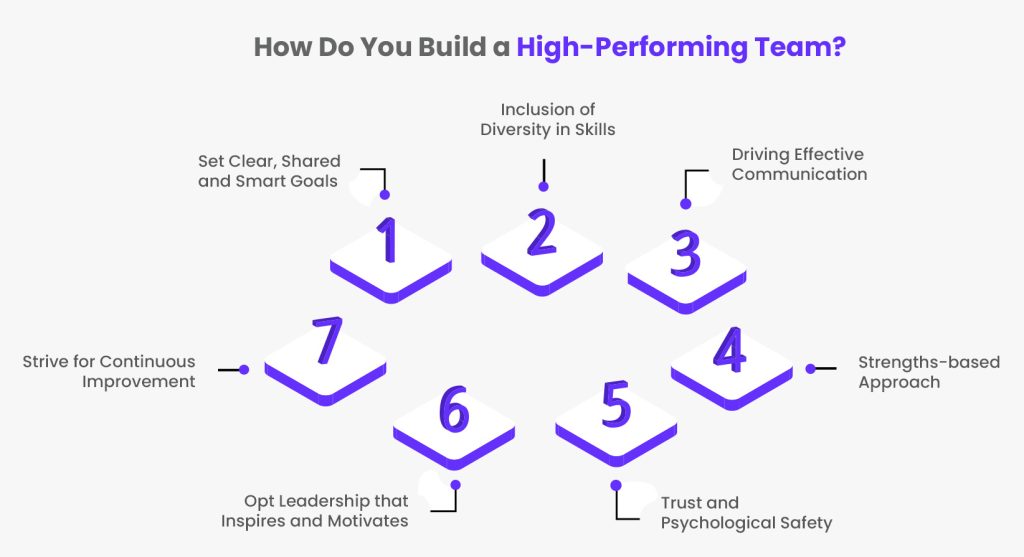
Do you have high performing team members in your team who take over complex and sensitive situations and get work done in a quality manner?
High-performing teams are breeding grounds for innovation and creativity. They specialise in working on set goals efficiently and quickly. In this blog, we discuss 7 ways to build a high-performing team.
How Do You Build a High Performing Team?
It takes a combination of many factors to build a great high performing team.
Every little strategy plays a role, from setting goals and analysing strengths and weaknesses to effective communication and mutual trust on the team abilities.

Set Clear, Shared and Smart Goals
The first step to building high performing teams is to have a clear direction. Set clear and shared goals both individually and team-wise. These goals should align with a greater objective i.e., the highest outcome you want to achieve.
Begin by clarifying every team’s objective and then define their specific goals. Divide the goals to each team member and let them know how their goal helps the organisation overall with the achievement of the main organisational objective.
Your goals should be specific, measurable, actionable, relevant and timed to be the best division of goals. Remember clear goals provide direction and focus, aligning people towards a common vision.
Inclusion of Diversity in Skills
Diversity and inclusion play key drivers in building the success of a high-performing team. Every individual part of your team possesses their forte of skills. Giving them a platform and an opportunity to shine in their respective area of expertise is your task.
When you foster an inclusive environment that values and empowers people belonging to different socio-economic backgrounds, a shared sense of belongingness is developed. Diverse perspectives, despite giving rise to differences in opinions, bring fresh and innovative ideas to the table, sometimes resulting in a completely new strategy when combined. An inclusive and safe workspace enhances the collective capabilities of people, creating a strong base for a high performing team.
Driving Effective Communication
Effective communication is a no-brainer when it comes to resolving conflicts and overcoming challenges arising within the teams.
Regular communication needs to happen for seamless exchanges of ideas and opinions and the smooth functioning of your team. This includes creating and maintaining open channels of communication amidst a healthy environment for all work communications to facilitate freely.
An environment of transparent communication builds trust and strengthens relationships within the team. Feedback, criticism and appreciation navigate situations of misunderstandings, enabling quick dissolution of conflicts in the face of adversity.
Strengths-based Approach
A strength-based approach where people are allowed to focus on what they do best drives better outcomes.
At SBL, we understand the importance of using the individual strengths of all team members to our organisation’s advantage.
At the heart of every high performing team lies the collective power to strive for greatness in everything they do.
Each member is bound to have their unique skills and strengths. As a manager, you have to ensure that the assigned tasks align with their strengths, leveraging their skills and areas of expertise to a team’s advantage in the best possible manner.
Trust and Psychological Safety
Every work environment requires intentional effort and commitment from managers to build trust among team members.
People who feel confident in each other’s abilities and intentions are more willing to collaborate and offer support. Such kind of psychological safety, reliance and trust are necessary for a smooth functioning team. Even in the face of conflicts, valuing each other’s opinions and feedback becomes the backbone of a high performing team.
Opt Leadership that Inspires and Motivates
Being an effective leader, you can steer your team to perform better each time.
A skilled leader sets the tone, provides direction, and cultivates an environment where team members can thrive and excel. When you lead by example, people naturally follow your steps.
Provide continuous guidance and support through team-building activities to keep your team motivated. Recognising contributions and providing support to your team members sound easy but can get tricky when you have to get down to it.
Only when you provide them with a positive work culture that boosts morale and makes them feel accountable for the results they bring, will you fulfill your innate responsibilities as an effective leader.
Strive for Continuous Improvement
Continuous improvement and individual growth of your people should be a priority of a high-performing manager if it isn’t already.
Continuous improvement begins with a culture that values learning and development. Create an environment where team members are encouraged to upskill their knowledge and seek out new experiences. Empowered teams with their enhanced capabilities easily adapt to business situations never faced before and excel in finding better solutions.
Summary
Building and leading a high performing team isn’t a one-day task. Your constant efforts, strategies, and effective leadership determine whether your team can be a high-performing one or not. Once you establish clear strategies, focus on making your team capable of achieving big goals. A strength-based approach paves the way for a high performing team, resulting in the best outcomes with the least resource usage.
Follow me on LinkedIn
Frequently Asked Questions
1. What makes a team high-performing?
A high-performing team is committed to the organisation’s goals and takes ownership of their roles and responsibilities, facilitating business success. They embrace a growth mindset, seek feedback, and strive for excellence through continuous improvement and innovation.
2. How to lead a high-performing team?
Here’s how you must lead a high-performing team:
1. Define clear, achievable goals for the team.
2. Ensure alignment between individual and team goals with the organisation’s objectives.
3. Show commitment to the team’s goals and lead with enthusiasm and passion.
4. Encourage active listening and facilitate constructive dialogue among team members.
5. Offer guidance and provide the necessary resources, tools, and training to help team members reach their full potential.
6. Trust team members to deliver results and provide autonomy to execute their responsibilities.
7. Encourage a culture of continuous learning and development within the team.
By implementing these strategies and providing growth opportunities, you can effectively lead a high-performing team that achieves set goals with outstanding results.




Quinn Goodwin
This asset is unbelievable. The wonderful information exhibits the distributer’s earnestness. I’m stunned and anticipate more such mind blowing entries.
This site is incredible. The radiant material shows the manager’s enthusiasm. I’m dumbfounded and envision more such mind blowing material.
donzaleigh regev
chiye branch
pesya vizcarro
jawanza merkle